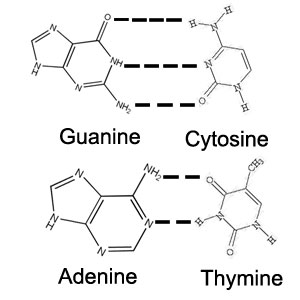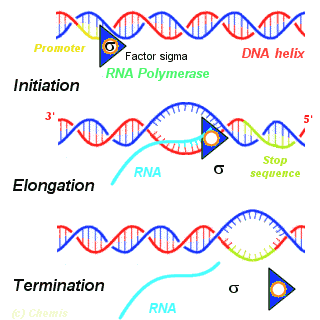 |
Main Menu |
|||
Introduction to Molecular GeneticsIt is obvious that traits are passed on from one generation to the next by some mechanism. The field dedicated to studying this transmission of traits became known as Genetics. Early experiments by geneticists Hershey and Chase determined that the transmission of traits was due to a substance called Deoxyribosenucleic Acid (DNA). It was determined later that the method by which DNA works to carry and transmit information about the organism was through its sequence of nitrogenous bases:
The structure of DNA is a double helix where Adenine is complement to Thymine and Guanine is complement to Cytosine (as shown in the image above). The sequence of these bases along a strand of DNA determines the function of the DNA at that location (called a locus). The primary purpose of DNA, therefore, is to provide the genetic code for proteins to be made, which is the manifestation of the genetic code. The first step in this process is the transcription of DNA, where a DNA Polymerase protein binds to the DNA and transcribes a copy of the template DNA called mRNA. The following diagram shows this process in a simplistic manner:
After the mRNA has left the nucleus, the sequence of the mRNA strand gets interpreted to form proteins, biological compounds that act as the building blocks of most cellular function. This process is called Translation, and occurs at proteins called ribosomes. Proteins are made up of structures called Amino Acids bonded together in a sequence specified by the mRNA strand. Every 3 nucleotides (nitrogenous base plus the sugar backbone of nucleic acids) represent a codon, and depending the codon, the ribosome will add a specific Amino Acid to the protein being synthesized. These proteins ultimately mediate most cellular functions and determine almost all of the features that are expressed in organisms. Thus, an organism's DNA provides the sequence that determines the proteins, and ultimately, the traits expressed by the organism. Cells divide and grow, which is the basis behind development of organisms such as humans. In order for this to work, however, an organism's genome must replicate every time the cell divides, so that all newly formed cells have a copy to operate the cell with. In most cells, the process of cell division includes a process of genome duplication and division called Mitosis. During this process, cellular proteins called DNA Polymerase I and II, in conjunction with other proteins, unwind the double stranded DNA into two complementary single stranded DNA, and add complementary nucleotides to each strand. Thus, this results in the synthesis of two identical strands of DNA from the original strand of DNA. From there, the DNA condenses into chromosomes, each composed of two identical sister chromatids, which divide into each daughter cell, giving each resulting daughter cell a copy of the original genome. The protein responsible for most of the DNA replication activity (DNA Polymerase II) will have very important implications in the field of genetics for use in PCR and DNA sequencing. Most organisms of the same species has an almost identical genetic code. The issue of how come different people have such differences in traits comes up, even though we are all part of the same species. The basis of this is the process of genetic mutation in germ line cells, which are passed on from one generation to the next. Mutations include point mutations (ie, a specific nucleotide gets mutated from Adenine to Guanine), deletions of nucleotides, or chromosomal disjunction. While the last two will not be discussed, point mutations that are passed on from generation to generation are called Single Nucleotide Polymorphisms. Mutations(SNPs) that aren't fatal and can be passed on from generation to generation often gets dispersed in the population. Accumulation of different random mutations that are passed on to future generations in forms such as SNPs account for the variation in physical appearance, biological physiology, and health of different people. These SNPs give genetic research its purpose, as many of these SNPs often result in diseases such as heridetary diabetes, cystic fibrosis, sickle cell anemia, and heridetary retinoblastoma. Laboratory techniques have been developed, and in combination with the use of computers, have allowed geneticists to undertake large-scale projects in hoping to find and remedy the genetic basis of many human diseases. |
||

